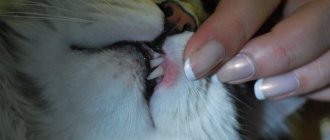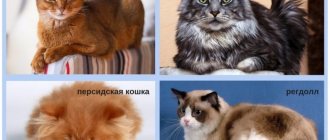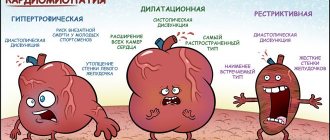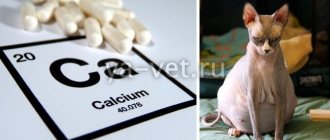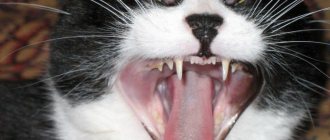Inflammatory diseases are among the most common pathologies occurring in cats. Owners of young pets often encounter the phenomenon of eosinophilic granuloma in cats. This disease is accompanied by damage to the skin and mucous membranes, causing severe discomfort to the animal. The oral cavity becomes most inflamed.
What it is?
To summarize, we can say that this term refers to a wide group of inflammatory diseases of the skin of animals. There are various clinical forms, in many cases differing significantly in the nature of their course, but nevertheless an inflammatory reaction is almost always observed. Most often, the skin is affected on some part of the body, as well as the oral cavity (pictured).
Initially, it was believed that this disease could be initiated by dozens of reasons, including parasites, poor-quality food, stress and environmental influences, but today scientists are inclined to think that in almost all cases granuloma is a peculiar manifestation of a local and general allergic reaction. In most cases, skin lesions are very itchy, and therefore the animal constantly licks and scratches them.
Often this pathology is one way or another associated with flea dermatitis. Since owners for a long time do not attach any importance to the constant licking of their pet, the disease can go very far.
Causes of eosinophilic granuloma in cats
The root cause of eosinophilic granuloma is usually an allergic reaction - an increased response of the animal's immune system to any substance. This mechanism can be triggered by the presence of parasites, both internal (helminths, protozoa) and external (ticks, fleas). An allergic reaction to flea bites comes first. Reaction to various foods, chemicals and plants. It takes time for the immune system to develop a food allergy, so it is wrong to think that it occurs to a recently introduced food into the diet. Hypersensitivity to airborne allergens (atopic dermatitis) is also a very common problem. The substances that cause it can be very diverse - pollen, house dust, mold. There is no age or breed predisposition to the appearance of granuloma, but it is more often recorded in young animals (from 3-5 years).
What is this disease like?
Currently, veterinarians distinguish several forms of this pathology, including mixed cases. But we will look at the most common and typical:
- Eosinophilic ulcer (painless lesion). These growths occur on the edge of the cat's upper lip (on one or both sides). It should be noted that in this case the ulcer forms relatively quickly, covers a significant surface, and the affected area may swell noticeably. In particularly severe situations, the damage covers almost the entire cat’s face, and in the future, symptoms of eosinophilic granuloma in cats can be seen anywhere on the body.
- Eosinophilic plaque. They can develop anywhere, but are most often found on a cat's stomach. Appearance – expanded, flattened “patties” on the body, their surface is usually red or dark pink. As a rule, hair does not grow on the plaques themselves; they are very itchy, which is why the cat constantly licks them. Gradually, these lesions spread over the entire surface of the abdomen.
Principles of therapy
It is important to remember that eosinophilic granuloma does not arise due to damage to the skin, but due to systemic reactions of the body. For this reason, the use of local medications, such as emulsions or ointments, does not achieve the desired effect. Therapy of the pathology is based on the use of the following hormonal drugs:
- Prednisolone.
- Dexamethasone.
- Triamcinolone.
Steroids are injected subcutaneously or given to the cat in tablet form. The duration of treatment should not exceed 21 days. The dosage is determined by the veterinarian. When symptoms subside, the dose of the drug is gradually reduced. Hormonal therapy is supplemented with drops and ointments that relieve itching, antiparasitic drugs and vitamin complexes.
In severe cases, when there is no relief after taking steroids, immunosuppressants are prescribed. These drugs inhibit the body's defense reactions, which are activated in the presence of allergens.
There are several types of immunosuppressants:
- glucocorticosteroids;
- calcineurin inhibitors;
- cytostatics;
- antihistamines;
- monoclonal antibodies.
If immunodeficiency is detected, immunobiological drugs are prescribed. They are divided into several groups:
- Obtained from live or killed bacteria, fungi, viruses.
- Based on the action of antibodies.
- Substances of plant origin with a wide spectrum of activity.
- Immunomodulators.
If a pathological change in the mucous membranes and skin causes severe discomfort to the animal or interferes with normal food intake, the affected tissue is excised. To exclude the occurrence of relapses, surgical intervention must be combined with conservative therapy.
Symptoms
Most often, single nodules are found on the surface of the skin, the surface of which is very dense and even rough. Sometimes the lesions take the form of nodules or ulcers. Significant tissue swelling in the same place is observed quite often. There is redness and ulcers appear, but there is no pain. As we have already said, the whole body can be affected, but the “favorite” places of occurrence are the muzzle and the inner surface of the hind limbs. In many cases, upon examination, swelling of local lymph nodes is detected.
If lesions have developed in the mouth, the animal cannot eat and drink normally, and therefore signs of exhaustion and dehydration quickly increase.
Diagnostics
The veterinarian must distinguish this pathology from many other skin diseases that have similar symptoms. A similar clinical picture can be caused by fungal, bacterial or viral infections, tumors of benign or malignant etiology, abscesses, and idiopathic diseases. To confirm the diagnosis and exclude other causes, a professional histological examination of tissue is required. In this case, the specialist will identify characteristic signs of inflammation, as well as the presence of a huge number of eosinophils in the tissue. These are blood cells associated with the manifestation of the inflammatory mechanism. In addition, they are often detected in allergies.
Thus, microscopic phenomena with eosinophilic granuloma are relatively typical, and therefore there will be no particular difficulties in diagnosis. The difficulty lies perhaps in differentiating the various forms of this disease, but in practice the need for this is highly doubtful. Of course, an experienced veterinarian will be able to confidently make a diagnosis based on visual signs.
Once a diagnosis has been made, the specialist should focus on identifying the underlying cause (especially allergic etiology). Very often, this disease develops after something insignificant: a cat’s fleeting contact with household chemicals, an insect bite, or the introduction of a new type of food into the diet. So before prescribing treatment, an allergy test must be carried out.
Of course, in many cases, identifying a specific allergen can take a really long time (up to several weeks). But this is really important, since this approach allows you to correctly prescribe symptomatic treatment and avoid the use of drugs that may be dangerous. Unfortunately, some cases of eosinophilic granuloma may be associated with autoimmune diseases, which can be very difficult to identify and diagnose.
Be careful! The fact is that the same lichen that is transmitted to humans can in some cases cause similar clinical signs. So, if you have any problems with your cat’s skin, immediately contact a veterinary clinic, otherwise you may be in for an unpleasant surprise!
How is this treated?
There is still no convincing evidence that any microorganisms can cause the development of eosinophilic granuloma. But it is known for sure that microbes sharply worsen the course of this disease due to the development of a secondary bacterial infection. In all these cases, a course of antibiotic therapy can help. Antimicrobial drugs will not eliminate the cause of the disease, but will significantly alleviate the animal’s condition. The duration of taking antibiotics is at least two to three weeks.
Treatment of eosinophilic granuloma in cats largely depends on the degree of neglect of the process and the underlying cause that caused the disease. If no predisposing factors can be identified, symptomatic therapy is used. In the case when all visible manifestations are represented by one or two small sores, then they can be left altogether (provided that they do not bother the cat). When the process initially shows a tendency to further spread, treatment should begin immediately.
Glucocorticoids (steroids) are the most common and very effective treatment and are almost always used for granuloma. They eliminate inflammation well and, in addition, significantly relieve itching. Duration and dose vary depending on the physiological condition and age of the cat. Sometimes older cats have to be prescribed long-term treatment with steroid drugs in small doses, since in their case it can be difficult to achieve long-term remission of the disease.
But this is dangerous, since the side effects of long-term use of hormonal drugs can be very serious. If long-term treatment is expected, it is better to consider alternative methods. These include the following:
- Antihistamines, which can help in almost all cases, as they effectively relieve itching. This treatment is available at home, but you should still consult your veterinarian first.
- Immunosuppressants such as cyclosporine or chlorambucil. They are useful if granuloma has developed against the background of autoimmune diseases.
- Prescription of hydrocortisone. This drug also belongs to the hormonal category, but its use does not cause dangerous side effects.
Forecast and tips
What is the prognosis and prospects for a sick animal? If the granuloma was caused by an allergen, and it was possible to identify and localize it, then everything is guaranteed to be fine. In cases where the skin lesions were more severe, some animals may require a long course of antihistamines. In this case, the prognosis may lean towards questionable, since such skin damage may not heal for a very long time. In general, this often happens after long-term use of steroid drugs, due to a weakened immune system.
What advice can you give to owners of such animals? Firstly, even after recovery, it is necessary to constantly monitor their health in order to notice signs of relapse of the disease in time. Secondly, it doesn’t hurt to consult with an experienced veterinary dermatologist and allergist to choose the most harmless diet. If possible, it is better to use special food that does not contain allergens.
Thirdly, if your cat is sick, and the process is complicated by a secondary infection, pay attention to maintaining hygiene: regularly remove the released exudate, cut off the hairballs that are stuck together. Any antiseptic ointment can also be used. Finally, take your pet to the veterinarian regularly for frequent checkups.
Rules for caring for a sick animal
The main thing in care is to reliably protect the cat from the action of factors that trigger immune restructuring. It is important to carefully follow the regimen of giving medications (corticosteroids are given at the same time), taking control tests and visiting the veterinarian. In addition, do the following:
- replace the litter in the cat’s tray with a hypoallergenic one, as well as its dishes and bed;
- protect the cat from self-harm, feed it properly, keep the room and the cat clean;
- Treat your cat against fleas, ticks, and helminths;
- limit the cat’s freedom of movement if it is on a self-walk - this will protect the cat from eating found food, repeated infections with fleas, worms and ticks, as well as from disruption of the medication regimen;
- watch the cat, keep a diary, take photographs;
- treat skin lesions with ointments or antiseptic solutions.
When caring for a cat with eosinophilic granuloma, treatment for helminths, fleas, and ticks is carried out.
Thus, with correct diagnosis and, if possible, frequent outpatient monitoring, in many cases it was possible to improve life and increase the period of remission to 6–8 months. Most cats are still living or have managed to live to be 12–16 years old.
Diet
Nutrition is of great importance, because in cases where the granuloma is caused by a food allergy, the diet takes on the importance of etiotropic therapy and its observance ensures the cure of the cat. In this case, it is better to use hypoallergenic veterinary food from trusted manufacturers: Royal Canin, Hills and others. If the cat is on natural feeding, then it should receive food that it has not received before. For example, the first week - rabbit meat, the second - elk, the third - turkey, the fourth - lamb. All this time the cat should be monitored. Limiting fat in your cat's diet is important because pancreatitis can easily occur during corticosteroid therapy. Under no circumstances should you give your cat food from the table. Cats who are ill for a long time may develop a body weight deficit: their food should contain a sufficient amount of protein - meat, fish, poultry, low-fat cottage cheese.
This is interesting: The cat has black specks on its chin
